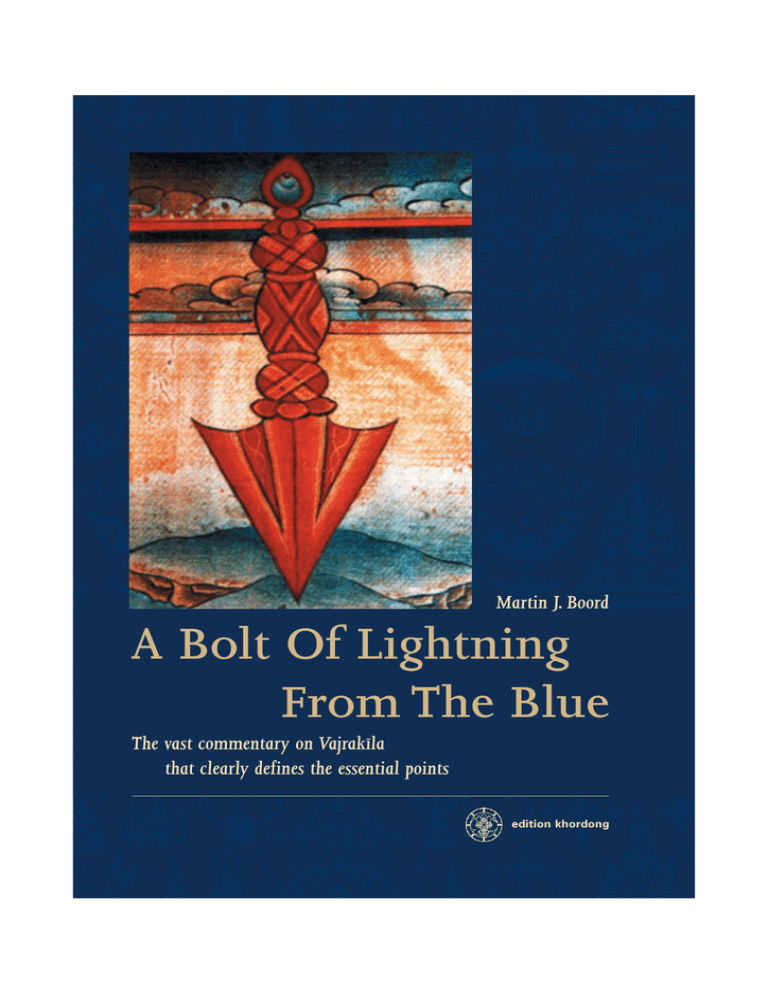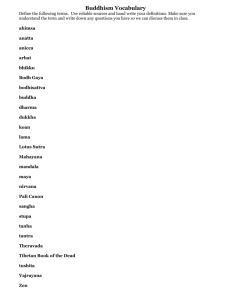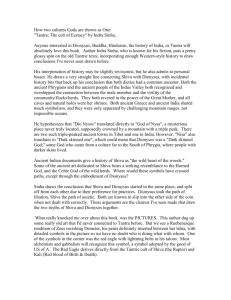
Martin J. Boord
A Bolt Of Lightning
From The Blue
The vast commentary on Vajrakı-la
that clearly defines the essential points
edition khordong
A Bolt Of Lightning From The Blue
This is a limited edition of 130 books
for sponsors of edition khordong
the non-profit publication house
of Khordong e.V. in Germany
Thanks a lot to all of our Sponsors!
May peace prevail on earth.
A Bolt Of Lightning
From The Blue
The vast commentary on Vajrakı-la
that clearly defines the essential points
annotated translations
by Martin J. Boord
including
Phur ’grel ’bum nag
as transmitted to
Ye-shes mtsho-rgyal
edition khordong berlin 2002
The line drawings included in this book are taken with friendly permission of Robert
Beer from his book “The Encyclopedia of Tibetan Symbols and Motifs” published by
Serindia Publications, London.
This book has been realised with the help of many sponsors around the world. Grateful
acknowledgement is due to their financial support of this project.
Die Deutsche Bibliothek –
CIP-Cataloguing-in-Publication-Data
A catalogue record for this publication is
available from Die Deutsche Bibliothek.
ISBN 3-936372-00-4
No part of this book may be reproduced in any form without prior written permission
of the publisher.
© 2002 Martin Boord
Published by edition khordong
All rights reserved.
First Edition 1000, 2002
is the publication house of the non-profit Khordong e.V. in Germany.
Please visit our website: www.khordong.net
Contact: edition@khordong.net
edition khordong
Typesetting and design by Andreas Ruft, Berlin
Cover design by Lisi Poller-Frischengruber, Vienna
Printed at Weihert Druck GmbH, Darmstadt, Germany
Bound by Buchbinderei Schaumann, Germany
Contents
Translator’s preface
Dramatis personae
Indian origins
Arrangement of the Hundred Thousand Words
Subsequent spread of the doctrines
Doctrinal themes in the ’Bum nag
India and Tibet
Sources & Acknowledgements
xiii
xvii
xxii
xxvii
xxix
xxxvii
xxxxi
EPISODE I
Sanskrit sources for the study of kılanavidhi
Kau˛ilya, ArthaŸ›stra
Sudhanakum›r›vad›na
Kuladatta, Kriy›saªgrahapañjik›
MañjuŸrımÒlakalpa
ƛmara-tantra
Siddhaikavıra-mah›tantra
Ca˚˜amah›ro˝a˚a-tantra
Mah›sukhavajrap›da, Padminı
Heruk›bhid›na-tantra
Saªvarodaya-tantra
Sarvatath›gatatattvasaªgraha
Guhyasam›ja-tantra
Candrakırti, Pradıpoddyotana
N›g›rjuna, Pañcakrama
MuniŸrıbhadra, Yogimanohar›
Vajrap›˚i (commenting on Heruk›bhid›na-tantra)
⁄ubh›karagupta, Abhisamayamañjarı
Kum›rakalahaªsa, Saªvararahasyas›dhana
Paramarahasya-tantra
finandagarbha, Sarvavajrodaya
Laghuk›lacakra-tantra
⁄rı Pu˚˜arıka, Vimalaprabh›
Dharm›karaŸ›nti, K›lacakrabhagavats›dhanavidhi
(Laghuk›lacakra-tantra)
(⁄rı Pu˚˜arıka, Vimalaprabh›)
PadmaŸrımitra, Ma˚˜alop›yik›
Durjayacandra, Mitapad›
Abhay›karagupta, Vajr›valı
3
3
5
18
19
20
21
24
25
25
26
26
28
46
49
54
55
57
58
59
61
62
63
67
67
70
70
71
EPISODE II
rDo rje phur pa rtsa ba’i rgyud kyi dum bu, Fragment of the Root Tantra
79
EPISODE III
dPal rdo rje phur pa spu gri nag po’i rgyud, The Black Razor Tantra
93
EPISODE IV
Translated text of the Phur ’grel ’bum nag
vi
INTRODUCTION
contents
General overview of the Vajrakıla doctrines
(1) The way of summarizing tantra into two
(a) root tantra
(b) explanatory tantra
(2) The three methods of tantric exegesis
(a) explanation of the Kıla doctrines in accordance with mah›yoga tantra
(b) explanation of the Kıla doctrines in accordance with anuyoga ›gama
(c) explanation of the Kıla doctrines in accordance with atiyoga upadeŸa
(3) The six hidden precepts (six bindings) of tantra
(4) The ten steps of tantric engagement
(5) The twelvefold list of the essential points of tantra
(6) The twenty-one tantra possessing the key to the life force
(7) The fifty-one fundamental Kıla deities
(8) The two thousand six hundred and one auxillary gods
110
110
110
110
110
110
111
111
111
111
112
112
112
Special presentation of the practice lineage
(1) The nid›na that introduces the guru
(a) his lineage of birth
(i) womb birth and miraculous emanation
(ii) worldly and supramundane families
(iii) four kinds of greatness
(iv) four degrees of vidy›dhara
(v) eight secret code names
113
113
113
113
113
113
113
118
119
120
123
124
124
128
129
129
131
132
135
135
135
135
138
138
138
141
141
141
DETAILED ANALYSIS OF THE VAJRAKÊLA DOCTRINES
The six bindings (chings) or hidden precepts (khog don) of tantra
PART ONE the higher rites:
Attainment of unsurpassed awakening
(1) To hold to the foundation of actions, attaining success by means of
the five excellences
(a) the excellent person
(b) the excellent place
(c) the excellent retinue
(d) the excellent time
(e) the excellent engagement
(i) provisions of food for sustenance
(ii) provisions of antidotes to avert misfortune
(iii) provisions for the divine attainments
(iv) provisions for the fulfilment of vows
(v) provisions for the destruction of enemies and obstructors
143
143
144
146
146
148
148
148
149
151
151
vii
contents
(b) his deeds and activities
(i) attainment of worldy power and siddhi
(ii) subjugation of dangerous beings of the eight classes
(iii) consecration of bSam-yas vih›ra
(c) the transmission of his tradition
(i) siddha lineage
(ii) lineage of ordinary folk
(2) The nid›na that introduces the teacher
(a) the special object to be tamed
(b) the special being who tamed him
(c) the special method of taming
(3) The nid›na that introduces the tantra
(a) the time when the vajra vehicle of secret mantra arose
(i) the circumstances in which the tantra were taught
(ii) the period during which they appeared in the human realm
(b) classification of the Dharma within nine y›na
(i) the explanation that accords with the trik›ya
(ii) explaining the series of nine y›na
(c) classification of the tantra of Vajrakıla
(i) from the standpoint of relative truth
(ii) from the standpoint of absolute truth
contents
viii
(2) Establishing the essential layout of the triple ma˚˜ala, together with the
preparatory methods of its prior approach
(a) seven stages of the approach (sngon ’gro, preliminary practices)
(i) establishing the boundaries (sım›bandha)
(ii) opening the symbolic door
(iii) paying homage to the symbols
(iv) adopting the sect-marks (rtags gdab pa)
(v) confession of sins
(vi) the descent of blessings
(vii) sanctifying the three articles
(b) three stages of generating the reality of the triple ma˚˜ala
(i) generating the triple sam›dhi of the basis
the sam›dhi of thusness
the all-illuminating sam›dhi
the sam›dhi of cause
(ii) generating the ma˚˜ala palace of residence
(iii) generating the deities who reside there
the fundamental dharmak›ya ma˚˜ala of the primordial state
the saªbhogak›ya ma˚˜ala of wrathful kings
the nirm›˚ak›ya ma˚˜ala of material kıla
154
154
154
156
156
156
157
158
158
163
163
164
167
169
171
177
177
185
194
(3) With regard to the empowerment of long life by the triple world, one
empowers the life force of the wisdom gods by means of the life force
203
(4) Invoking the wisdom deities of the ma˚˜ala, one takes the essence of
siddhi through offerings and ritual service
(a) invitation of the wisdom deities
(i) prayers of supplication
(ii) the actual invitation
(b) presenting them with eight kinds of offerings
(i) offerings made with the hands to the ma˚˜ala in the sky
(ii) the absorption [of the wisdom beings] and offerings of
embrace made by four goddesses
(iii) offering the bali cake (gtor ma)
(iv) offering the nectar medicine (bdud rtsi sman)
(v) offering the blood of the three terminations (tshar gsum)
(vi) offering union and slaughter (sbyor sgrol)
(vii) praying for what we want
(viii) offerings to the assembly and hymns of praise
(c) performing the ritual service (sev›)
(d) taking siddhi at the time of the offerings
205
205
205
205
206
206
206
209
211
212
214
216
218
220
221
PART TWO the lower rites:
Annihilation of enemies and obstructors
(5) Endowed with the transmitted precepts (›gama) of cleansing ablution, the
transmitted precepts of longevity and the six techniques of hidden mantra,
one performs the rite of implantation
223
(a) the six techniques of hidden mantra
223
(b) the transmitted precepts of cleansing ablution and of longevity
228
(c) the genuine rite of implantation
231
(6) The final three activities of pressing down, burning and hurling
(a) pressing down
(b) burning
pacification homa
enriching homa
overpowering homa
fierce homa
(c) hurling
234
234
240
240
240
240
240
244
contents
PART THREE
Further analysis
The ten steps of tantric engagement
(1) The general points are covered by three kinds of nid›na or introduction
(2) The meaning is made clear by the threefold definition (lak˝a˚at›)
(a) defining the ma˚˜ala
(b) defining the mantra
(c) defining the materials required in the rite
(3) Kıla of four materials that penetrate the four extremes
(a) the kıla of wisdom awareness
(b) the kıla of emanated compassion
(c) the kıla of secret bodhicitta
(d) the material kıla with signs
(4) Straightening out the rules of the activities by three great traditions of
practice
(5) The wisdom deities are caused to enter the vital point by means of the
all-encompassing mantra
(6) The ˜›kinı are really incited by means of malign spells of 18 assembled
syllables in three groups of six
(7) The vital essence of the three visualizations is expressed in accordance
with the three meanings of ‘life force’
(8) Black deeds are performed by means of 18 great traditions of liberation
(9) Ritual activity is supplemented by eight masteries
(10) All rites are discharged by the three extreme subjugations
ix
251
251
251
254
257
259
259
260
261
263
266
267
268
269
270
271
272
The twelvefold list of the essential points of tantra
contents
x
(1) If one does not know the six far-reaching lines of liturgical verse,
the higher activities cannot be distinguished from the lower
(2) If one does not know the six techniques of hidden mantra, the fierce
mantra nail cannot wound the enemy
(3) If one does not know the six hidden connections, the concealed
secrets cannot be understood
(4) If one does not know the scissors which are the life force of the oral
instructions, the life force of the enemies and obstructors will not
be severed
(5) If one does not know the rite of the great billowing wings, the
soul of the enemies and obstructors will not be drawn forth
(6) If one does not know the ritual of the secret kıla which is a lion’s
roar of argumentation, the yogin has no method of liberation from
internal dispute
(7) If one does not know the method of determining the central point,
engaging in activities will only rebound
(8) If one does not know the method of turning the wheel,
one’s activities will not be accomplished
(9) If one does not know the method of equipping the effigy,
the focal point of the visualizations will be worthless
(10) If one does not know the true nature of the fundamental ground,
the implantation will be meaningless
(11) If one does not know the deeper intention of the precepts of longevity
and the ablution water, there will be mere malign mantra
(12) If one does not know the rites of elevating to a higher plane,
one will be merely a butcher
273
273
274
275
276
277
279
279
280
280
280
281
The four kıla
(1) The sky-like practitioner nails the kıla of wisdom awareness into the
ground of the dharmadh›tu
(2) The mountain-like practitioner nails the kıla of the rope of embracing
compassion into the ground of all sentient beings in the triple world
(3) The practitioner who is like a kalantaka bird nails the kıla of secret
bodhicitta into the mother’s sky
(4) The practitioner who is like the trunk of a sandalwood tree nails the
material kıla into the enemies and obstructors
282
284
286
289
Three groups of malign mantra
The outer system of the DHADDHI mantra
The inner system of the assembly (’dus pa)
The secret system of combination (bsdu yig)
Implantation of the kıla in accordance with the traditions of slaughter
294
295
297
299
Tantra, ›gama and upadeŸa
Root texts, transmitted precepts and oral instructions
301
303
xi
305
307
308
309
310
311
311
312
313
315
318
320
321
322
324
326
328
332
336
336
339
342
343
contents
The arousal of bodhicitta
An explanation of the empowerments
(a) the instructions
(b) the practice
the vase empowerment
the secret empowerment
the wisdom knowledge empowerment
the fourth empowerment
The method of deity generation and its seals (outer utpattikrama)
sam›dhi of creative meditation
the yoga of the generation stage, which is skilful method
the yoga of the completion stage, which is wisdom
the yoga of both together, which is non-dual
Accepting the accomplishments (siddhi)
generating accomplishments by means of s›dhana
absorbing the accomplishments
developing the accomplishments
(inner utpattikrama)
(secret utpattikrama)
The view of infallible perception
The code of conduct that reaches the ultimate goal
Sacred oaths that are not to be transgressed
The rite of implantation
The seven-day observance for the dead
The rite of cremation (‘inner homa rite’)
Preparation of votary or reliquary s›ccha
Installation of the deity
Regulations of the ritual service
ordinary recitation
special recitation
three deeds of refreshing sustenance
EPISODE V
Verses of aspiration for success in the practice of Vajrakıla
347
APPENDIX
Bibliography
Index
contents
xii
353
359
P REFACE
Dramatis personae
The main text presented in this volume is the Phur ’grel ’bum nag, The Black One
Hundred Thousand [words] Commentary on the Kıla. The title ‘Black One Hundred
Thousand’ indicates a complete cycle of teachings (’bum), vast in its scope, that is
clearly defined and precise (nag po) in its methodological application. This
‘unambiguous and clear set of teachings from which nothing has been omitted’
has at its heart the deliberations of three ›c›rya, Padmasambhava, Vimalamitra,
and the Nepali ⁄ılamañju, who extensively revised and commented upon all
that they had heard of kıla lore whilst cloistered away together in a religious
retreat at Yang-le-shod (present-day Pharping, Nepal).
This work is of seminal importance for it clearly witnesses the very origin of
the cult of Vajrakıla. It was precisely during this retreat that the many strands
of kıla lore were finally woven together into a coherent masterpiece of tantric
Buddhism and thus it helps to illuminate the process by which tantric methods
were being related to soteriology at this time. Beautifully codified in terms of
both theory and practice, this divine scheme of meditation and magic was subsequently transmitted to Tibet and became established there as one of the major
modes of religious engagement. So much so, in fact, that many previous writers on Tibet have actually assumed the kıla cult to be of Tibetan origin.
According to traditional accounts, the doctrines of Vajrakıla were first taught
among the gods and n›ga before being transmitted to the human realm. They
were subsequently propagated in India by IndrabhÒti, Dhanasaªsk¸ta,
⁄rısiªha, Prabhahasti and an unnamed k›p›lika brahmin. Kıla chronicles, such
as the Concise History1 written by gTsang mkhan-chen and the gNam lcags spu gri
lo rgyus chos ’byung by bDud-’joms rinpoche, say that these Vajrakıla doctrines
were taught by IndrabhÒti to Dhanasaªsk¸ta who then passed them on to Padmasambhava, Vimalamitra and ⁄ılamañju. These three companions addition1
The Phur pa’i chos ‘byung bsdus pa is to be found in gTsang mkhan-chen, rDo rje phur
pa’i chos ‘byung pp.161-196. Published by Taklung Tsetrul, Darjeeling, 1979.



